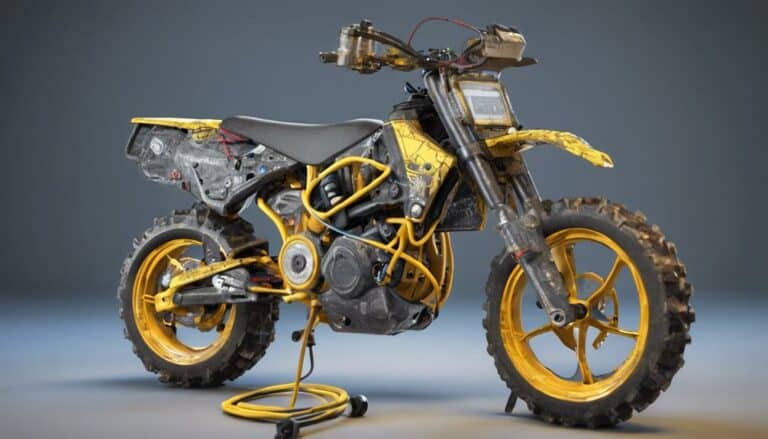To test continuity of electrical components on a dirt bike: Disconnect battery wires. Set up multimeter in continuity mode. Check for consistent beep or '0' reading. Use multimeter across wires/connectors. Look for uninterrupted signal and wiggle to find issues. Inspect insulation for damage. Test components individually with multimeter. Identify and address faulty parts. Check battery terminals, starter cable, switches, diodes. This precise procedure guarantees accurate testing. Follow this method to diagnose and fix electrical issues effectively.
Key Takeaways
- Disconnect battery, set up multimeter in continuity mode, and check for continuous signal to test wires and connectors.
- Inspect insulation for damage like cracks or discoloration to prevent short circuits.
- Test components individually using multimeter in continuity or resistance mode, referring to wiring diagram for accurate testing.
- Identify and repair faulty parts such as corroded battery terminals, frayed starter cables, and faulty switches.
- Look for issues causing open circuits like diode problems and ensure all connections have intact insulation.
Disconnecting the Battery and Setting Up Multimeter
Before proceeding with testing the electrical components on your dirt bike, it's essential to disconnect the battery and set up your multimeter correctly. Start by locating the battery on your bike and disconnecting the negative (black) wire first, followed by the positive (red) wire. This step is vital to prevent any electrical mishaps during testing.
Next, you'll need to set up your multimeter for testing continuity. Turn the dial to the continuity or diode check mode, usually denoted by a diode symbol. Make sure your multimeter probes are in good condition and securely connected. Now, connect one probe to one end of the electrical component and the other probe to the opposite end.
When you touch the probes to the component, a continuous beep or a '0' reading on the multimeter indicates a good electrical circuit. This method ensures that you can accurately assess the continuity of the electrical components on your dirt bike.
Checking for Continuity Across Wires and Connectors
To ensure a thorough examination of the electrical system on your dirt bike, utilize a multimeter set to continuity mode for checking the integrity of wires and connectors. Begin by connecting the multimeter probes to each end of the wire or connector under inspection to test for a continuous signal. A continuous beep or a '0.000' reading on the multimeter indicates good continuity, ensuring that there's minimal resistance along the path of electrical flow.
While conducting the continuity test, it's advisable to gently wiggle the wires or connectors to detect any intermittent issues that may arise. By checking each wire and connector individually, you can pinpoint any faulty components within the system. This methodical approach will help you identify and address any disruptions in the complete path of electrical flow, ensuring peak performance and functionality of your dirt bike's electrical system.
Inspecting Insulation for Damage
Regularly inspect the insulation of electrical components on your dirt bike for any cracks, tears, or signs of wear to guarantee maximum functionality and safety. Damaged insulation can lead to short circuits, electrical malfunctions, or even potential hazards while riding. Here is a table summarizing key points to take into account when inspecting insulation for damage:
| Inspection Tips | Description |
|---|---|
| Cracks, tears, or exposed wires | Check for visible damage that compromises the insulation's protective function. |
| Discoloration | Look for any abnormal color changes, indicating potential overheating or damage. |
| Melted or deformed insulation | Inspect for any melting or deformation that could point to short circuits. |
| Close examination | Use a magnifying glass or flashlight to thoroughly examine insulation for wear. |
| Securely covered connections | Ensure all electrical connections have intact insulation to prevent malfunctions. |
Testing Each Component Individually
When testing each individual component on your dirt bike's electrical system, utilize a multimeter set to the continuity or resistance mode for accurate assessment.
Start by disconnecting the electrical components from the power source. Set your multimeter to the appropriate mode and confirm the positive lead is connected correctly. Refer to the wiring diagram specific to your dirt bike model for accurate testing procedures.
First, test the ignition coils. Touch one probe to each end of the coil and measure the resistance. A good coil typically shows a specific resistance range.
Next, test the source coil by following the same procedure. Then, move on to the voltage regulator and CDI box, checking for continuity in each component.
Identifying and Repairing Faulty Parts
Inspect each electrical component for signs of damage or wear to identify and address any faulty parts in your dirt bike's system.
Start by checking the battery terminal for corrosion or loose connections. Next, examine the starter cable for any fraying or breaks that could disrupt the flow of electricity.
If the issue persists, test the switch first to confirm it's functioning correctly. Measure the AC voltage to determine if the electric starter is receiving the necessary power.
Look for any diode and connect issues that may be causing an open circuit. Check the ground or ground wire for any faults that could be affecting the system.
If continuity isn't detected, verify the resistance is measured correctly in each component. Finally, test the ignition to pinpoint any faulty parts like switches, coils, or wiring harnesses that may need repairing for peak performance of your dirt bike's electrical system.
Conclusion
To conclude, testing the continuity of electrical components on a dirt bike necessitates patience and precision.
By disconnecting the battery, setting up a multimeter, checking for continuity across wires and connectors, inspecting insulation for damage, testing each component individually, and identifying and repairing faulty parts, you can guarantee the smooth operation of your bike.
Remember, thorough testing is essential to maintaining the electrical system's integrity and ensuring a safe and reliable ride.

